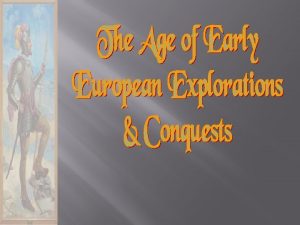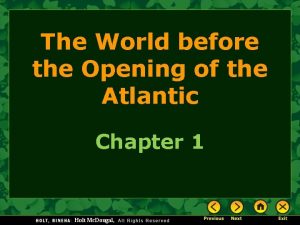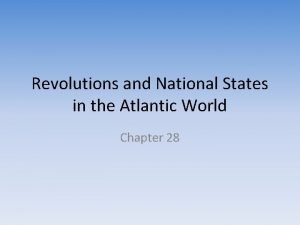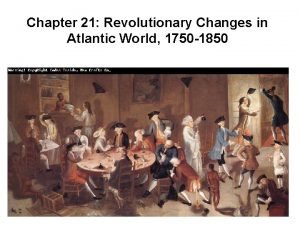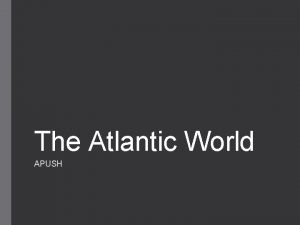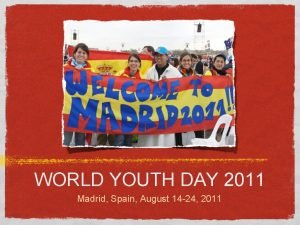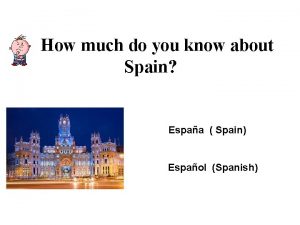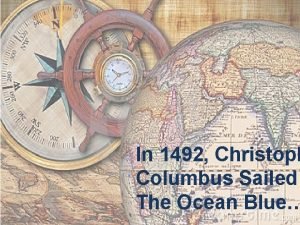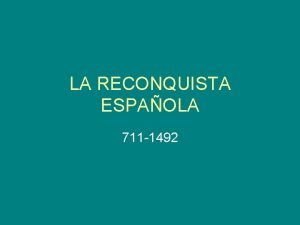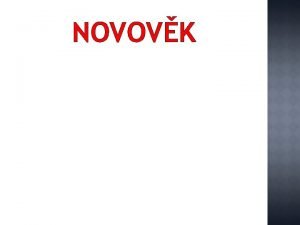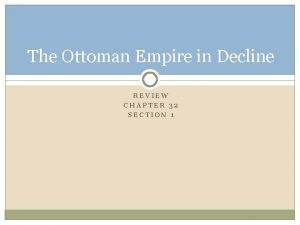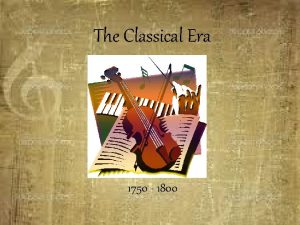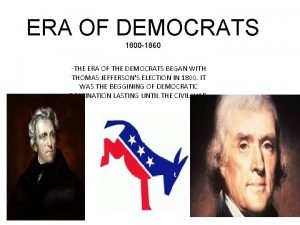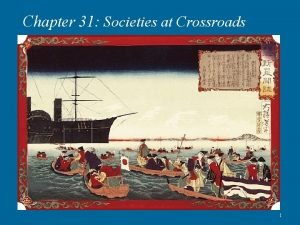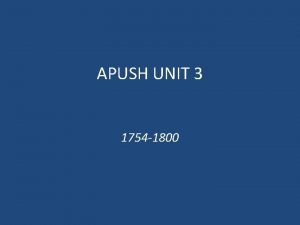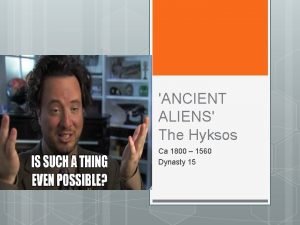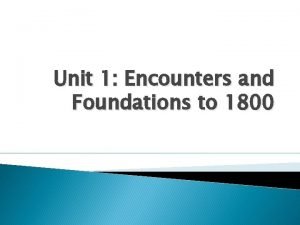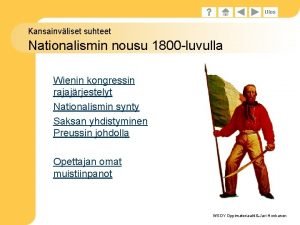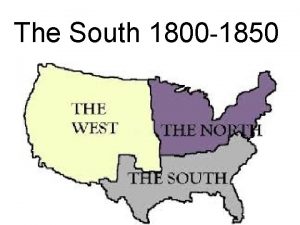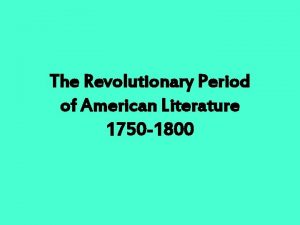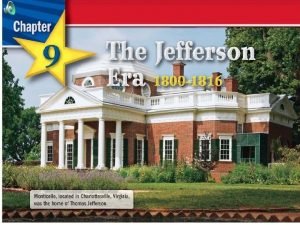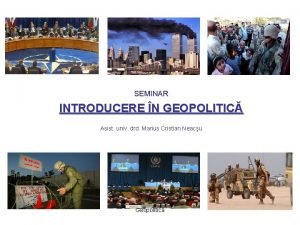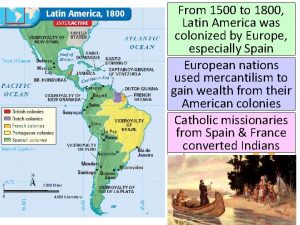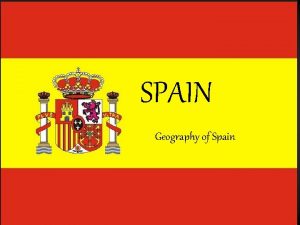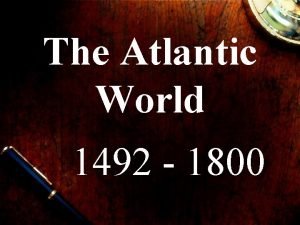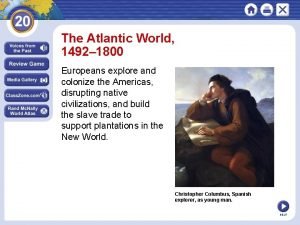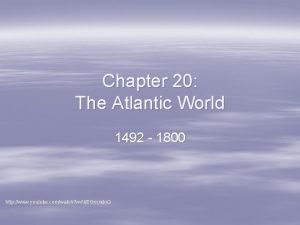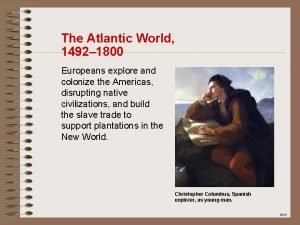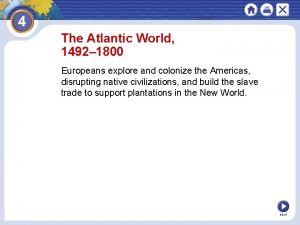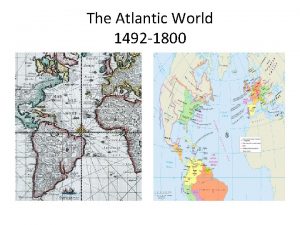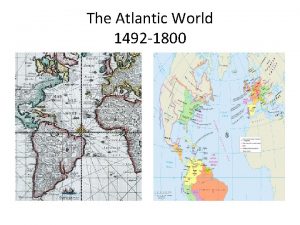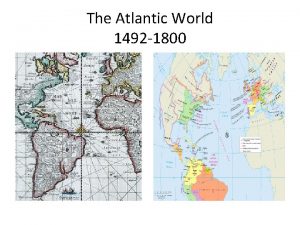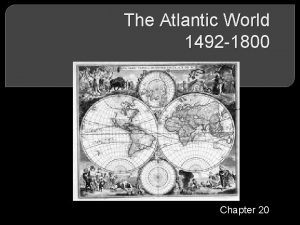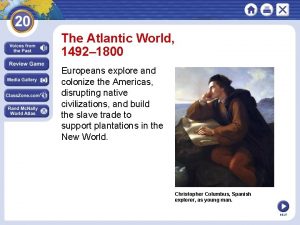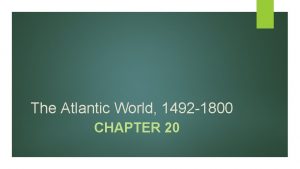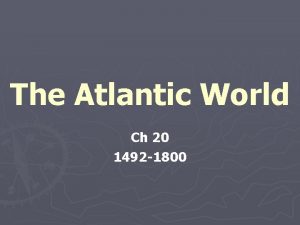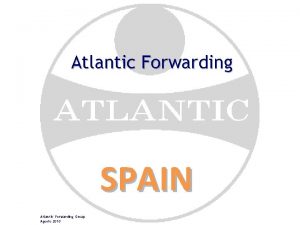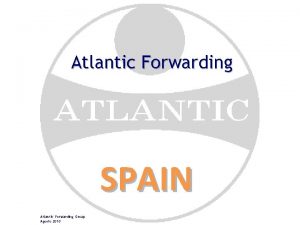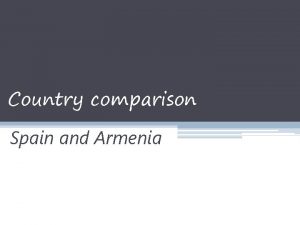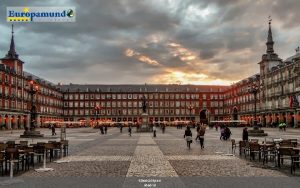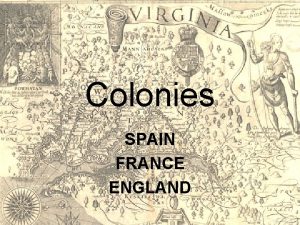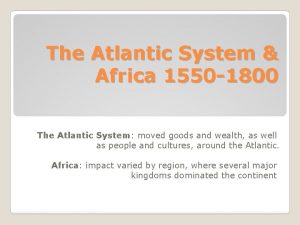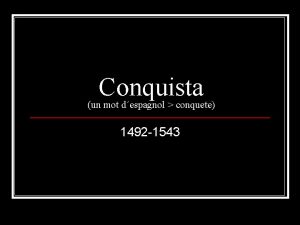Ch 20 The Atlantic World 1492 1800 Spain











































































- Slides: 75

Ch 20 The Atlantic World 1492 -1800

Spain Builds an American Empire Sec 1

Columbus • Fierce competition among European nations for wealth prompted Christopher Columbus to make a daring voyage from Spain in 1492 • Columbus

Voyage • Instead of sailing around Africa to reach Asia, Columbus sailed west in search of an alternate route • On August 3, 1492, the Nina, Pinta, and Santa Maria sailed out of a Spanish port



The Encounter • The Encounter- Columbus’s discovery of the Americas • On October 12, 1492, the Pinta caught sight of the shore • Thinking he had reached the East Indies, Columbus called the inhabitants of the island Indians • Scholars believe he reached shore on an island in the Bahamas


Colonization • Columbus claimed the island he discovered and named in Salvador • Finding no gold there he searched other islands and claimed them for Spain • After returning to Spain, Columbus got permission and financing for three more trips • He traveled not as an explorer but as an empire builder

Colonies • Spain intended to transform the islands of the Caribbean into colonies or lands that are controlled by another nation

Other Explorers • In 1500, Portuguese explorer Pedro Alvares Cabral claimed Brazil for his country • In 1501, Amerigo Vespucci, explored the coast of South America and reported back that it was a “new” world and not Asia • Ferdinand Magellan became the first to circumnavigate the world when his crew returned to Spain in 1522 • Magellan




Conquistadors • In 1519, Hernando Cortes, landed on the shores of Mexico • Cortes marched inland looking to claim more land for Spain • Cortes and the many Spanish explorers who followed him were known as conquistadors (conquerors)


Conquistadors • Lured by rumors of vast lands filled with gold, the Spanish carved out colonies in regions that would become Mexico, South American, and the United States • As a result of Spanish colonization they greatly enriched their empire and left a mark on the cultures of the Americas that still exists today

Aztecs • Soon after landing in Mexico, Cortes learned of the vast and wealth Aztec Empire in the region’s interior • After marching for weeks, Cortes and 600 of his men reached the capital of Tenochtitlan • Aztec emperor Montezuma II believed that Cortes was a god dressed in armor and gave him a share of the empire’s gold

Fall of the Aztecs • Not happy with the amount of gold he was given Cortes killed many Aztec warriors and chiefs during a religious ceremony • Briefly driven out by an Aztec rebellion in 1520, Cortes and his men conquered the Aztecs in 1521


How was Cortes’ small group of soldiers able to take out an entire empire?

Spanish Advantages • Superior weaponry • Help of native groups that were enemies of the Aztecs • Disease – The native population in central Mexico decreased from 25. 3 million in 1519 to 1 million in 1605

Peru • In 1532, conquistador Francisco Pizarro, marched a small force into Peru to conquer the Incan Empire • After kidnapping and betraying Incan leader Atahualpa, Pizarro was able to conquer the Inca without a struggle



Spanish Conquest • When conquering the natives the Spanish lived among them and imposed their culture on them • The Spanish settlers known as peninsulares were mostly men. • Relationships between the peninsulares and native women led to a large mestizo, or mixed population

Encomienda System • In order to exploit the land, the Spanish forced Native Americans to work within a system known as encomienda • Under this system natives farmed, ranched, or mined land for Spanish landlords • The landlords received the rights to the native’s labor from Spanish authorities and were supposed to take care of the natives in return but most were abused and worked to death



Portuguese in Brazil • Finding little gold or silver, the Portuguese began to grow sugar in Brazil • Huge plantations were cleared from forest land natives were used for labor

Spanish Influence Expands • The American colonies helped make Spain the richest, most powerful nation in the world during much of the 16 th century • Spanish conquistadors continued to expand north into the southwestern United States • Finding little gold in the southwest, the conquistadors left settling the land to Catholic priests

Opposition • As Spanish priests worked to spread Christianity in the Americas they also pushed for better treatment of the natives • Bartolome de las Casas- Priest who spoke out against the encomienda system • De las Casas suggested using Africans for labor instead, something he later regretted • Many tribes of natives tried to fight back but none were successful for very long


European Nations Settle North America Sec 2

Other Countries • Spain’s successful colonization efforts did not go unnoticed • Other nations such as England, France, and the Netherlands soon became interested in obtaining their own colonies

Northwest Passage • Magellan’s voyage showed that it was possible to reach Asia by way of the Pacific Ocean • Other countries began to look for a northwest passage, an easier, more direct route to the Pacific • Not finding the route, the French, English, and Dutch established colonies in North America

New France • In 1524, Giovanni da Verazzano, an Italian in service of France, sailed to North America and discovered New York harbor • Ten years later, Jacques Cartier, discovered the St. Lawrence River • In 1608, Samuel de Champlain sailed up the St. Lawrence with 32 settlers and established Quebec, which became the capital of New France

New France • After the establishment of Quebec the French moved to the interior of North America


The English • In 1607, the English established a permanent settlement in Jamestown in modern Virginia • Jamestown Game • In 1620, the Pilgrims established a second English colony, Plymouth, in Massachusetts



The Dutch • Following the French and English into North America were the Dutch • In 1609, Henry Hudson was exploring for a northwest passage to Asia when he discovered the Hudson River and Hudson Bay • The Dutch claimed the areas along these waterways and established a fur trade with the Iroquois




The Dutch • The Dutch built trading posts at Fort Orange (Albany) and New Amsterdam (Manhattan) • The new colony was called New Netherlands • The Dutch were slow to attract settlers so they gradually opened the colony to other countries and many Germans, French, and Scandinavians settled there



English Oust the Dutch • To the English, New Netherlands separated their northern and southern colonies • In 1664, the Duke of York arrived with a fleet and the Dutch surrendered without a shot and the colony was renamed New York • By 1750, about 1. 2 million English settlers lived in the 13 colonies

England vs France • In order to handle the growing population, the English continued to push west into the continent causing conflicts with the French • In 1754, the French and Indian War broke out over land in the Ohio River Valley • As a result of the war the English seized control of the eastern half of the US


Disease • Just like the Spanish colonies, the Native Americans in North America were greatly affected by disease • One tribe was reduced from 24, 000 members in 1616 to 750 members in 1631 • As a result of the deaths there was a severe labor shortage in the colonies that led the colonists to look to Africa

Slave Trade • Sugar plantations and tobacco farms required a large supply of workers to make them profitable • Slavery had existed in Africa for centuries • The spread of Islam into Africa increased the trade as Muslims believed they could sell non. Muslim prisoners of war into slavery • Slaves in Muslim and African society had some legal rights and opportunity

Why did the Europeans choose to use Africans for slaves?

Demand for Africans • Many Africans had already been exposed to European diseases • Many Africans had experience in farming • Africans were less likely to escape than Native Americans because they did not know the land • Skin color made it easier to catch them if they did escape

Atlantic Slave Trade • Atlantic Slave Trade- buying and selling of Africans for work in the Americas • By the time the slave trade ended around 1870, 9. 5 million Africans had been imported • More than 40% of all Africans went to Brazil

African Cooperation and Resistance • Many African rulers and merchants played a willing role in the slave trade • Most European traders waited in ports as African merchants captured Africans to be enslaved

Triangular Trade • Triangular Trade- trading network between Europe, Africa, and the Americas

Middle Passage • Middle Passage- middle leg of the triangular trade route that brought Africans to the Americas characterized by sickening cruelty and brutality • 20% of all slaves died on the journey






What was life like for a slave?

Consequences • Many cultures in Africa lost generations of their fittest members • Families were torn apart • Guns were introduced to Africa • Slave labor contributed greatly to the economic and cultural development of the Americas

Columbian Exchange • Columbian Exchange- global transfer of foods, plants, and animals during the colonization of the Americas • Perhaps the most important were corn and potatoes that were introduced to Europe • These foods changed diets and helped people live longer


Disease • One part of the Columbian Exchange that greatly affected the world was disease • Millions of Native Americans died

Capitalism • Capitalism- economic system based on private ownership and the investment of resources for profit • No longer were governments the sole owners of great wealth

Mercantilism • Mercantilism- economic theory that a country’s power comes from wealth • Every nation was trying to become as rich as possible • The colonies existed solely for the benefit of the mother country • Countries sought to develop a favorable balance of trade where they sold more goods than they bought


Economic Revolution • The economic revolution in Europe spurred the growth of many cities and towns and the rise of merchants who controlled great wealth

 Ap world history chapter 25 africa and the atlantic world
Ap world history chapter 25 africa and the atlantic world Maps before 1492
Maps before 1492 The world before the opening of the atlantic
The world before the opening of the atlantic Revolutions and national states in the atlantic world
Revolutions and national states in the atlantic world Chapter 21 revolutionary changes in the atlantic world
Chapter 21 revolutionary changes in the atlantic world Anglicization apush
Anglicization apush Wyd madrid 2011
Wyd madrid 2011 Spain map in world
Spain map in world Density dependent factors
Density dependent factors Christopher columbus sailed the ocean blue in 1492
Christopher columbus sailed the ocean blue in 1492 1492-711
1492-711 Paminklas
Paminklas Co se stalo roku 1492
Co se stalo roku 1492 West african societies around 1492
West african societies around 1492 Hình ảnh bộ gõ cơ thể búng tay
Hình ảnh bộ gõ cơ thể búng tay Lp html
Lp html Bổ thể
Bổ thể Tỉ lệ cơ thể trẻ em
Tỉ lệ cơ thể trẻ em Chó sói
Chó sói Glasgow thang điểm
Glasgow thang điểm Chúa yêu trần thế
Chúa yêu trần thế Các môn thể thao bắt đầu bằng tiếng đua
Các môn thể thao bắt đầu bằng tiếng đua Thế nào là hệ số cao nhất
Thế nào là hệ số cao nhất Các châu lục và đại dương trên thế giới
Các châu lục và đại dương trên thế giới Công thức tiính động năng
Công thức tiính động năng Trời xanh đây là của chúng ta thể thơ
Trời xanh đây là của chúng ta thể thơ Mật thư tọa độ 5x5
Mật thư tọa độ 5x5 Phép trừ bù
Phép trừ bù độ dài liên kết
độ dài liên kết Các châu lục và đại dương trên thế giới
Các châu lục và đại dương trên thế giới Thể thơ truyền thống
Thể thơ truyền thống Quá trình desamine hóa có thể tạo ra
Quá trình desamine hóa có thể tạo ra Một số thể thơ truyền thống
Một số thể thơ truyền thống Cái miệng bé xinh thế chỉ nói điều hay thôi
Cái miệng bé xinh thế chỉ nói điều hay thôi Vẽ hình chiếu vuông góc của vật thể sau
Vẽ hình chiếu vuông góc của vật thể sau Thế nào là sự mỏi cơ
Thế nào là sự mỏi cơ đặc điểm cơ thể của người tối cổ
đặc điểm cơ thể của người tối cổ V cc
V cc Vẽ hình chiếu đứng bằng cạnh của vật thể
Vẽ hình chiếu đứng bằng cạnh của vật thể Tia chieu sa te
Tia chieu sa te Thẻ vin
Thẻ vin đại từ thay thế
đại từ thay thế điện thế nghỉ
điện thế nghỉ Tư thế ngồi viết
Tư thế ngồi viết Diễn thế sinh thái là
Diễn thế sinh thái là Dạng đột biến một nhiễm là
Dạng đột biến một nhiễm là Số nguyên tố là gì
Số nguyên tố là gì Tư thế ngồi viết
Tư thế ngồi viết Lời thề hippocrates
Lời thề hippocrates Thiếu nhi thế giới liên hoan
Thiếu nhi thế giới liên hoan ưu thế lai là gì
ưu thế lai là gì Khi nào hổ con có thể sống độc lập
Khi nào hổ con có thể sống độc lập Sự nuôi và dạy con của hổ
Sự nuôi và dạy con của hổ Hệ hô hấp
Hệ hô hấp Từ ngữ thể hiện lòng nhân hậu
Từ ngữ thể hiện lòng nhân hậu Thế nào là mạng điện lắp đặt kiểu nổi
Thế nào là mạng điện lắp đặt kiểu nổi Map of ottoman empire 1800
Map of ottoman empire 1800 1800 classical music
1800 classical music 9300 to 34800
9300 to 34800 Nationalism 1800-talet
Nationalism 1800-talet British empire in 1939
British empire in 1939 French fashion 1800
French fashion 1800 Era of the democrats 1800-1860
Era of the democrats 1800-1860 Map of ottoman empire 1800
Map of ottoman empire 1800 1754 to 1800 apush
1754 to 1800 apush 1800-1560
1800-1560 Encounters and foundations to 1800
Encounters and foundations to 1800 Nationalismin synty
Nationalismin synty South 1800
South 1800 Romantic period american literature
Romantic period american literature Revolutionary period of american literature
Revolutionary period of american literature The election of 1800 showed that
The election of 1800 showed that Harta europei 1800
Harta europei 1800 1800-luvun aatteet
1800-luvun aatteet Medtronic sofamor danek usa
Medtronic sofamor danek usa Latin america 1500 to 1800
Latin america 1500 to 1800

